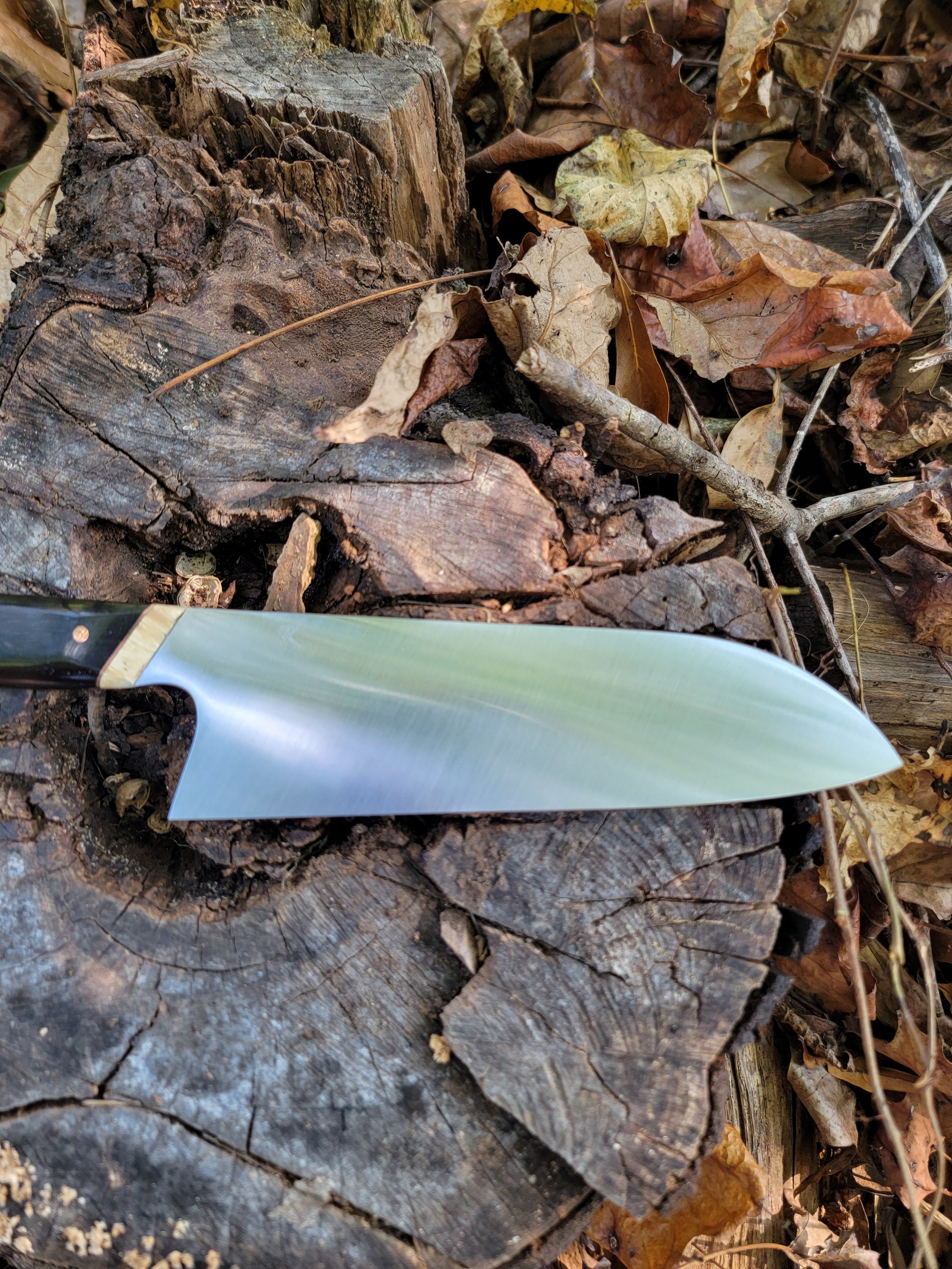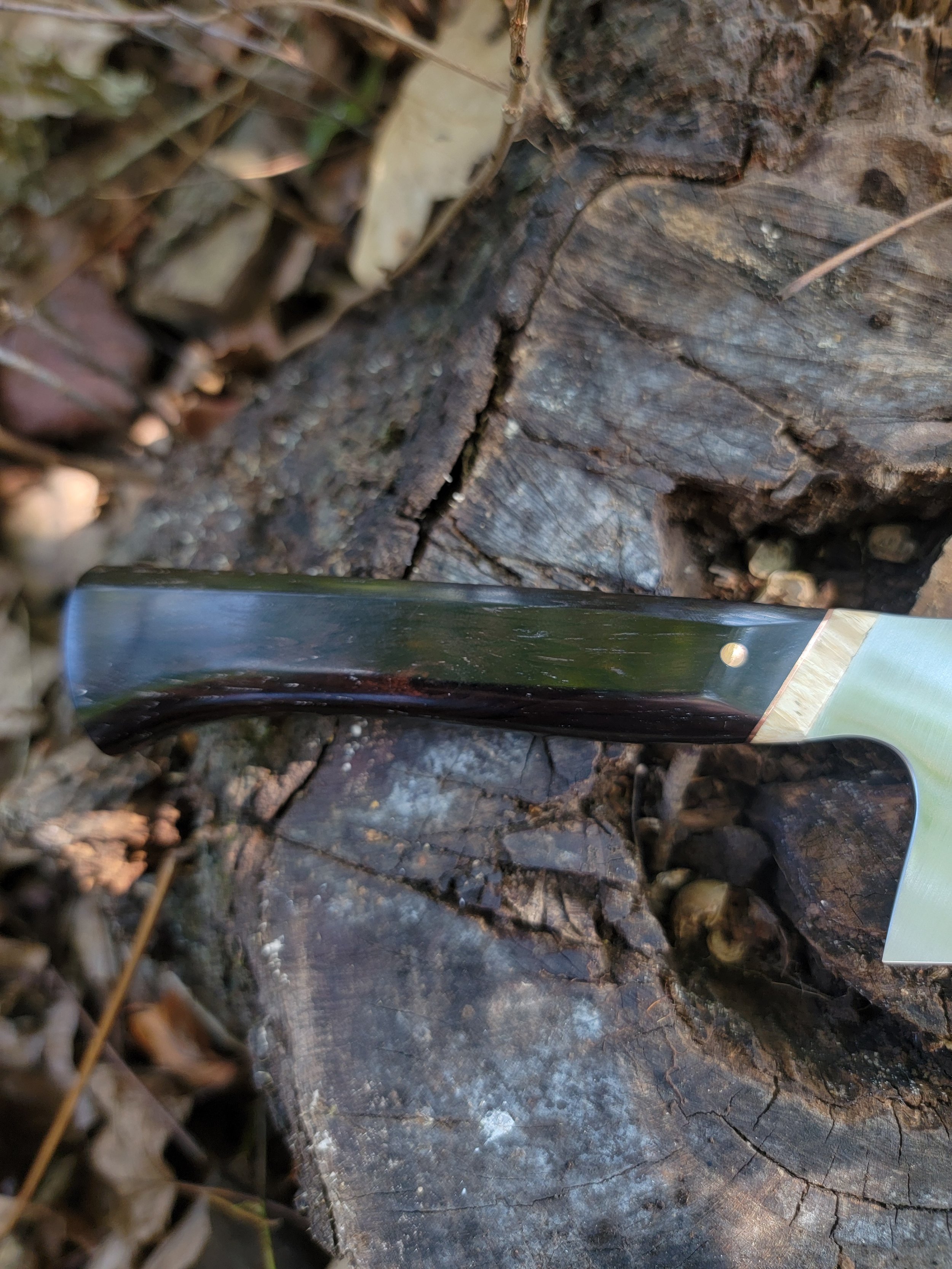 Image 1 of 7
Image 1 of 7

 Image 2 of 7
Image 2 of 7

 Image 3 of 7
Image 3 of 7

 Image 4 of 7
Image 4 of 7

 Image 5 of 7
Image 5 of 7

 Image 6 of 7
Image 6 of 7

 Image 7 of 7
Image 7 of 7








Stainless Santoku (Workhorse)
The santoku is a Japanese style kitchen knife that very versatile in the kitchen. Santoku in Japanese translates to the 3 virtues, meat fish and vegetables. Hence making it a jack of all trades and very versatile. The santoku has a flatter blade than a western style knife, a flatter blade can be a matter of preference but it does allow for more edge contact though the food at once, lends itself better to push chopping, and makes scooping food off the cutting board easier. One of the purposes behind the shape of the santoku is scooping food off the cutting board easier for the cook.
Knife details:
Blade length: 6.7”
Heel height: 2”
Handle length: 4.9”
Steel: NitroV Stainless
Handles material: African blackwood, box elder burl
Grind type: Walkschliff
Edge thickness and hardness: .005” 62 hrc
Edge angle 15 degrees
Weight: 4.6 oz
The walkschliff grind is a grind that is essentially a double convex grind. Meaning that both the edge and spine are tapered from the middle. This makes the cross section of the knife egg shaped. The reason why i've switched over to the walkschliff grind is
1. Because it adds lateral durability to the knife (including the tip) meaning more durability through hard use.
2. Adds blade stiffness without adding weight
3. In my opinion the best way to get effective food release
4. Adds edge durability without “wedging”. Wedging is when the knife cutting through the food medium is too thick and you experience drag while completing the cut.
Food release is the inability of food to stick to the side of the blade. It's something that isn't very easy to achieve as a knife maker, but professional and home cooks alike look for. In my experience and testing the walkschliff grind is the most effective at achieving this.
The santoku is a Japanese style kitchen knife that very versatile in the kitchen. Santoku in Japanese translates to the 3 virtues, meat fish and vegetables. Hence making it a jack of all trades and very versatile. The santoku has a flatter blade than a western style knife, a flatter blade can be a matter of preference but it does allow for more edge contact though the food at once, lends itself better to push chopping, and makes scooping food off the cutting board easier. One of the purposes behind the shape of the santoku is scooping food off the cutting board easier for the cook.
Knife details:
Blade length: 6.7”
Heel height: 2”
Handle length: 4.9”
Steel: NitroV Stainless
Handles material: African blackwood, box elder burl
Grind type: Walkschliff
Edge thickness and hardness: .005” 62 hrc
Edge angle 15 degrees
Weight: 4.6 oz
The walkschliff grind is a grind that is essentially a double convex grind. Meaning that both the edge and spine are tapered from the middle. This makes the cross section of the knife egg shaped. The reason why i've switched over to the walkschliff grind is
1. Because it adds lateral durability to the knife (including the tip) meaning more durability through hard use.
2. Adds blade stiffness without adding weight
3. In my opinion the best way to get effective food release
4. Adds edge durability without “wedging”. Wedging is when the knife cutting through the food medium is too thick and you experience drag while completing the cut.
Food release is the inability of food to stick to the side of the blade. It's something that isn't very easy to achieve as a knife maker, but professional and home cooks alike look for. In my experience and testing the walkschliff grind is the most effective at achieving this.
The santoku is a Japanese style kitchen knife that very versatile in the kitchen. Santoku in Japanese translates to the 3 virtues, meat fish and vegetables. Hence making it a jack of all trades and very versatile. The santoku has a flatter blade than a western style knife, a flatter blade can be a matter of preference but it does allow for more edge contact though the food at once, lends itself better to push chopping, and makes scooping food off the cutting board easier. One of the purposes behind the shape of the santoku is scooping food off the cutting board easier for the cook.
Knife details:
Blade length: 6.7”
Heel height: 2”
Handle length: 4.9”
Steel: NitroV Stainless
Handles material: African blackwood, box elder burl
Grind type: Walkschliff
Edge thickness and hardness: .005” 62 hrc
Edge angle 15 degrees
Weight: 4.6 oz
The walkschliff grind is a grind that is essentially a double convex grind. Meaning that both the edge and spine are tapered from the middle. This makes the cross section of the knife egg shaped. The reason why i've switched over to the walkschliff grind is
1. Because it adds lateral durability to the knife (including the tip) meaning more durability through hard use.
2. Adds blade stiffness without adding weight
3. In my opinion the best way to get effective food release
4. Adds edge durability without “wedging”. Wedging is when the knife cutting through the food medium is too thick and you experience drag while completing the cut.
Food release is the inability of food to stick to the side of the blade. It's something that isn't very easy to achieve as a knife maker, but professional and home cooks alike look for. In my experience and testing the walkschliff grind is the most effective at achieving this.